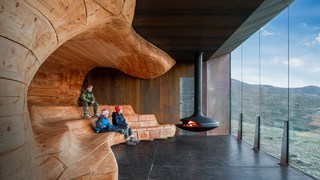TED Book: The Future of Architecture in 100 Buildings
Can cellphones influence architecture? Architect Marc Kushner, author of a new book, 'The Future of Architecture in 100 Buildings' thinks so—especially as more people look to take selfies with interesting backgrounds. His book showcases 100 buildings that capture what he sees as the future of architecture.— The Wall Street Journal
The Future of Architecture in 100 Buildings
by Marc Kushner
Through his unique position at the crossroads of architecture and social media, architect and Architizer.com founder Marc Kushner highlights 100 buildings, and the questions they seem to ask of us: How can we live smaller? Can a building breathe? With stunning photography and stories of architectural wonder from across the globe, The Future of Architecture in 100 Buildings illustrates the rapidly evolving world of architecture in the digital age.
iBooks Best Book of the Month
Watch the companion TED Talk
Where to buy
About the book

A pavilion made from paper. An inflatable concert hall. A building that eats smog. A bridge that grows grapes. The Future of Architecture in 100 Buildings captures the soaring confidence, the thoughtful intelligence, the futuristic wonder, and at times the sheer whimsy of the world's most inspired and future-looking buildings.
As author Mark Kushner explains, "The future of architecture is not one of any dominant style, but rather a world of constant innovation and experimentation." Like an architectural cabinet of wonders, the book captures this glorious global diversity: From soaring steel towers to bamboo bungalows; from iconic monuments to ingenious children's playgrounds, each page offers an unexpected glimpse of architecture's potential.
In the age of social media, buildings speak louder than ever. Everyone with a smartphone has become an architectural photographer, snapping selfies with the world's most photogenic buildings. And this constant stream of photos ensures that architecture is now in conversation with the world. Its future matters more – and to more of us – than ever.
Aimed at this new, broad audience for architecture, this is an essential and delightful guide to the future being built around us. Each page offers an easy entry point into some of the most innovative aspects of architecture in a way that's fun, witty and engaging. From designers who ask "Can architecture help us age?" to communities that wonder, "Could our kids play in a wasteland?" to high-tech innovators who asked "Can we live in meat?", The Future of Architecture in 100 Buildings throws light on the most fascinating challenges being addressed today by the world's most innovative design thinkers.
Press and reviews
"[Kushner] is an ideal candidate for this sort of project: founder of the architecture firm HWKN and the website Architizer.com, both of which operate out of the intention to make architecture accessible, part of a public dialogue.The 100 structures he examines here — some of which have not yet been built — highlight that objective, moving from the repurposed (a cathedral in the Netherlands that has been turned into a bookstore, a Brooklyn warehouse that is now a 73 room hotel) to the revolutionary (a floating pool in New York’s East River that would function as a kind of Brita filter, cleaning half a million gallons daily; a house on sleds, built in New Zealand, that can be towed inland from a flooding shore)."
— LA Times
"For all its wild, utopian ideas, Kushner’s book has also has a more simple, and very admirable aim: to make architecture more accessible...The projects in the book hint at a future that shirks sweeping trends in favor for countless mini-trends. And that’s exciting."
-Wired
"Across 176 vibrantly illustrated pages, ‘the future of architecture in 100 buildings’ proves an insightful and optimistic guide to the field’s present condition, while making valid and positive propositions regarding the future of the profession."
— Designboom
"It’s a beautiful little book with a photo of each building featured and a question each building seems to pose: A photo of Arctia Shipping Headquarters in Helsinki, Finland — an office that sits on the water, much like a barge — asks: Can an office float?"
— Bookish
"Following his enthralling 2014 TED Talk, Marc Kushner of Architizer has crafted the latest addition to the TED Books library. To explore how media influences architecture around the world Kushner focuses on 100 high-concept structures, ranging from an inflatable concert hall to a smog-eating hospital. Ultimately the 176-page hardcover shows how an informed society has joined the conversation concerning how buildings can best serve the social and ecological environments that surround them."
— Cool Hunting
“The future of architecture is a frenetic whirlwind of experimentation and a reevaluation of long-accepted habits,” writes Marc Kushner in the introduction to his new book The Future of Architecture in 100 Buildings. And it is being shaped, more than ever, by non-architects who use, rather than design, these structures."
— The Globe and Mail
"After his groundbreaking TED Talk on 30 years of architectural history, he’s now released a new TED Book, The Future of Architecture in 100 Buildings, which brings together 100 of today’s most radical designs for a new tomorrow."
— Buzzfeed
iBooks Best Book of the Month
WSJ slideshow: Watch
About the author
Marc Kushner is a practicing architect who splits his time between designing buildings at HWKN, the architecture firm he co-founded, and amassing the world's architecture on the website he runs, Architizer.com. Both have the same mission: to reconnect the public with architecture.
Kushner's core belief is that architecture touches everyone - and everyone is a fan of architecture - even if they don't know it yet. New forms of media empower people to shape the built environment, and that means better buildings that make better cities that make a better world.


